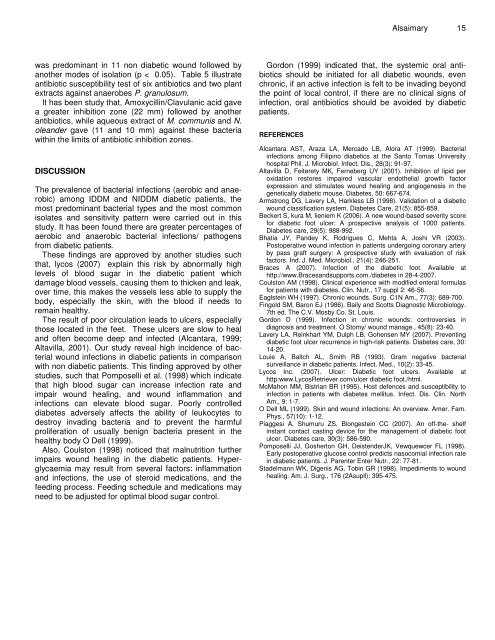Bacterial wound infections in diabetic patients and their therapeutic ...
Bacterial wound infections in diabetic patients and their therapeutic ...
Bacterial wound infections in diabetic patients and their therapeutic ...
Create successful ePaper yourself
Turn your PDF publications into a flip-book with our unique Google optimized e-Paper software.
was predom<strong>in</strong>ant <strong>in</strong> 11 non <strong>diabetic</strong> <strong>wound</strong> followed by<br />
another modes of isolation (p < 0.05). Table 5 illustrate<br />
antibiotic susceptibility test of six antibiotics <strong>and</strong> two plant<br />
extracts aga<strong>in</strong>st anaerobes P. granulosum.<br />
It has been study that, Amoxycill<strong>in</strong>/Clavulanic acid gave<br />
a greater <strong>in</strong>hibition zone (22 mm) followed by another<br />
antibiotics, while aqueous extract of M. communis <strong>and</strong> N.<br />
ole<strong>and</strong>er gave (11 <strong>and</strong> 10 mm) aga<strong>in</strong>st these bacteria<br />
with<strong>in</strong> the limits of antibiotic <strong>in</strong>hibition zones.<br />
DISCUSSION<br />
The prevalence of bacterial <strong><strong>in</strong>fections</strong> (aerobic <strong>and</strong> anaerobic)<br />
among IDDM <strong>and</strong> NIDDM <strong>diabetic</strong> <strong>patients</strong>, the<br />
most predom<strong>in</strong>ant bacterial types <strong>and</strong> the most common<br />
isolates <strong>and</strong> sensitivity pattern were carried out <strong>in</strong> this<br />
study. It has been found there are greater percentages of<br />
aerobic <strong>and</strong> anaerobic bacterial <strong><strong>in</strong>fections</strong>/ pathogens<br />
from <strong>diabetic</strong> <strong>patients</strong>.<br />
These f<strong>in</strong>d<strong>in</strong>gs are approved by another studies such<br />
that, lycos (2007) expla<strong>in</strong> this risk by abnormally high<br />
levels of blood sugar <strong>in</strong> the <strong>diabetic</strong> patient which<br />
damage blood vessels, caus<strong>in</strong>g them to thicken <strong>and</strong> leak,<br />
over time, this makes the vessels less able to supply the<br />
body, especially the sk<strong>in</strong>, with the blood if needs to<br />
rema<strong>in</strong> healthy.<br />
The result of poor circulation leads to ulcers, especially<br />
those located <strong>in</strong> the feet. These ulcers are slow to heal<br />
<strong>and</strong> often become deep <strong>and</strong> <strong>in</strong>fected (Alcantara, 1999;<br />
Altavilla, 2001). Our study reveal high <strong>in</strong>cidence of bacterial<br />
<strong>wound</strong> <strong><strong>in</strong>fections</strong> <strong>in</strong> <strong>diabetic</strong> <strong>patients</strong> <strong>in</strong> comparison<br />
with non <strong>diabetic</strong> <strong>patients</strong>. This f<strong>in</strong>d<strong>in</strong>g approved by other<br />
studies, such that Pomposelli et al. (1998) which <strong>in</strong>dicate<br />
that high blood sugar can <strong>in</strong>crease <strong>in</strong>fection rate <strong>and</strong><br />
impair <strong>wound</strong> heal<strong>in</strong>g, <strong>and</strong> <strong>wound</strong> <strong>in</strong>flammation <strong>and</strong><br />
<strong><strong>in</strong>fections</strong> can elevate blood sugar. Poorly controlled<br />
diabetes adversely affects the ability of leukocytes to<br />
destroy <strong>in</strong>vad<strong>in</strong>g bacteria <strong>and</strong> to prevent the harmful<br />
proliferation of usually benign bacteria present <strong>in</strong> the<br />
healthy body O Dell (1999).<br />
Also, Coulston (1998) noticed that malnutrition further<br />
impairs <strong>wound</strong> heal<strong>in</strong>g <strong>in</strong> the <strong>diabetic</strong> <strong>patients</strong>. Hyperglycaemia<br />
may result from several factors: <strong>in</strong>flammation<br />
<strong>and</strong> <strong><strong>in</strong>fections</strong>, the use of steroid medications, <strong>and</strong> the<br />
feed<strong>in</strong>g process. Feed<strong>in</strong>g schedule <strong>and</strong> medications may<br />
need to be adjusted for optimal blood sugar control.<br />
Alsaimary 15<br />
Gordon (1999) <strong>in</strong>dicated that, the systemic oral antibiotics<br />
should be <strong>in</strong>itiated for all <strong>diabetic</strong> <strong>wound</strong>s, even<br />
chronic, if an active <strong>in</strong>fection is felt to be <strong>in</strong>vad<strong>in</strong>g beyond<br />
the po<strong>in</strong>t of local control, if there are no cl<strong>in</strong>ical signs of<br />
<strong>in</strong>fection, oral antibiotics should be avoided by <strong>diabetic</strong><br />
<strong>patients</strong>.<br />
REFERENCES<br />
Alcantara AST, Araza LA, Mercado LB, Alora AT (1999). <strong>Bacterial</strong><br />
<strong><strong>in</strong>fections</strong> among Filip<strong>in</strong>o <strong>diabetic</strong>s at the Santo Tomas University<br />
hospital Phil. J. Microbiol. Infect. Dis., 28(3): 91-97.<br />
Altavilla D, Feiterety MK, Ferneberg UY (2001). Inhibition of lipid per<br />
oxidation restores impaired vascular endothelial growth factor<br />
expression <strong>and</strong> stimulates <strong>wound</strong> heal<strong>in</strong>g <strong>and</strong> angiogenesis <strong>in</strong> the<br />
genetically <strong>diabetic</strong> mouse. Diabetes, 50: 667-674.<br />
Armstrong DG, Lavery LA, Harkless LB (1998). Validation of a <strong>diabetic</strong><br />
<strong>wound</strong> classification system. Diabetes Care, 21(5): 855-859.<br />
Beckert S, kura M, lieniem K (2006). A new <strong>wound</strong>-based severity score<br />
for <strong>diabetic</strong> foot ulcer: A prospective analysis of 1000 <strong>patients</strong>.<br />
Diabetes care, 29(5): 988-992.<br />
Bhatia JY, P<strong>and</strong>ey K, Rodrigues C, Mehta A, Joshi VR (2003).<br />
Postoperative <strong>wound</strong> <strong>in</strong>fection <strong>in</strong> <strong>patients</strong> undergo<strong>in</strong>g coronary artery<br />
by pass graft surgery: A prospective study with evaluation of risk<br />
factors. Ind. J. Med. Microbiol., 21(4): 246-251.<br />
Braces A (2007). Infection of the <strong>diabetic</strong> foot. Available at<br />
http://www.Braces<strong>and</strong>supports.com./diabetes <strong>in</strong> 28-4-2007.<br />
Coulston AM (1998). Cl<strong>in</strong>ical experience with modified enteral formulas<br />
for <strong>patients</strong> with diabetes. Cl<strong>in</strong>. Nutr., 17 suppl 2: 46-56.<br />
Eaglste<strong>in</strong> WH (1997). Chronic <strong>wound</strong>s. Surg. C1N Am., 77(3): 689-700.<br />
F<strong>in</strong>gold SM, Baron EJ (1986). Baily <strong>and</strong> Scotts Diagnostic Microbiology.<br />
7th ed. The C.V. Mosby Co. St. Louis.<br />
Gordon D (1999). Infection <strong>in</strong> chronic <strong>wound</strong>s: controversies <strong>in</strong><br />
diagnosis <strong>and</strong> treatment. O Stomy/ <strong>wound</strong> manage., 45(8): 23-40.<br />
Lavery LA, Re<strong>in</strong>khart YM, Dulph LB, Gohensen MY (2007). Prevent<strong>in</strong>g<br />
<strong>diabetic</strong> foot ulcer recurrence <strong>in</strong> high-risk <strong>patients</strong>. Diabetes care, 30:<br />
14-20.<br />
Louie A, Baltch AL, Smith RB (1993). Gram negative bacterial<br />
surveillance <strong>in</strong> <strong>diabetic</strong> <strong>patients</strong>. Infect. Med., 10(2): 33-45.<br />
Lycos Inc. (2007). Ulcer: Diabetic foot ulcers. Available at<br />
http:www.LycosRetriever.com/ulcer <strong>diabetic</strong> foot./html.<br />
McMahon MM, Bistrian BR (1995). Host defences <strong>and</strong> susceptibility to<br />
<strong>in</strong>fection <strong>in</strong> <strong>patients</strong> with diabetes mellitus. Infect. Dis. Cl<strong>in</strong>. North<br />
Am., 9: 1-7.<br />
O Dell ML (1999). Sk<strong>in</strong> <strong>and</strong> <strong>wound</strong> <strong><strong>in</strong>fections</strong>: An overview. Amer. Fam.<br />
Phys., 57(10): 1-12.<br />
Piaggesi A, Shumuru ZS, Blongeste<strong>in</strong> CC (2007). An off-the- shelf<br />
<strong>in</strong>stant contact cast<strong>in</strong>g device for the management of <strong>diabetic</strong> foot<br />
ulcer. Diabetes care, 30(3): 586-590.<br />
Pomposelli JJ, Gosherton GH, DeistenderJK, Vewquewcer FL (1998).<br />
Early postoperative glucose control predicts nasocomial <strong>in</strong>fection rate<br />
<strong>in</strong> <strong>diabetic</strong> <strong>patients</strong>. J. Parenter Enter Nutr., 22: 77-81.<br />
Stadelmann WK, Digenis AG, Tob<strong>in</strong> GR (1998). Impediments to <strong>wound</strong><br />
heal<strong>in</strong>g. Am. J. Surg., 176 (2Asupll): 395-475.

















